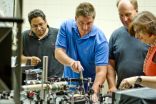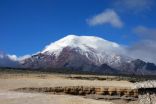(Press-News.org) BOSTON--September 14, 2015--Researchers from Harvard-affiliated Hebrew SeniorLife Institute for Aging Research (IFAR), in collaboration with scientists from a number of international institutes, have identified a genetic variant regulating a gene responsible for bone mineral density and fracture risk. Findings from this study--funded in part by grants from the National Institutes of Health (NIH)--are published in the journal Nature and could lead to interventions that may prevent fractures in older adults.
Osteoporosis, a word meaning "porous bone," is a disease that weakens bones, making them brittle and susceptible to fracture. According to the NIH, an estimated 53 million Americans have osteoporosis or are at risk of developing the disease due to low bone mass. Previous research has found risk factors such as age, gender, ethnicity, and family history contribute to the development of osteoporosis.
"Our study explores the hereditary aspect of osteoporosis by investigating the role our genes play in determining bone mineral density and who is at risk of fracture due to low bone density," explains senior author Douglas Kiel, M.D., M.P.H., Director of the Musculoskeletal Research Center at IFAR, Hebrew SeniorLife in Boston, Professor of Medicine, Harvard Medical School and Associate Member of the Broad Institute of Harvard and MIT. "Understanding the genomics underlying skeletal fragility (osteoporosis) may lead to preventative interventions that ultimately reduce fractures as we age."
For the present study, the research team sequenced the entire genome of more than 2,800 people and combined this with exome sequencing as well as another 3,500 people with "deep imputation" of their genotyping results, which is a way to fill in information about the unanalyzed portions of the genome by incorporating the data coming from the 2,800 people with sequencing of their genomes. The results confirmed that some of the genetic variants were associated with bone mineral density by comparing their data with information from more than 20,000 other research participants. The investigators then looked at data from many other studies (totaling more than half-a-million people) and determined that some of these variants also influenced a person's risk of breaking a bone.
Study results show that a gene involved at the earliest stages of human development, the engrailed homeobox-1 gene, plays a central role in regulating bone density. This is the first time that researchers have connected the gene's product, the protein EN1, to bone biology in adults. Furthermore, this study validates the use of whole-genome, sequencing-based discovery and deep imputation as sound methods for identifying novel genetic associations. "This study is one of several that have identified relatively rare sequence variants associated with complex phenotypes and disorders, such as osteoporotic fractures and low BMD in general populations, suggesting the value of applying whole genome sequencing in identifying genetic determinants of common disorders," according to Dr. Yi-Hsiang Hsu, one of the lead authors and a statistical geneticist at Hebrew SeniorLife Institute for Aging Research, Harvard Medical School, Harvard School of Public Health and the Broad Institute of Harvard and MIT.
Dr. Kiel says, "Our findings enhance understanding of the genetics underlying the development of osteoporosis. Ideally, genomic research will one day lead to more personalized interventions (precision medicine) that, in this case, will reduce bone loss and prevent fractures in older adults."
INFORMATION:
Dr. Kiel's work was funded by grants R01AR061162 and R01AR041398 from the NIH's National Institute of Arthritis and Musculoskeletal and Skin Diseases (NIAMS).This work is solely the responsibility of the authors and does not necessarily represent the official views of the NIAMS or NIH. This work was partially supported by the National Heart, Lung and Blood Institute's Framingham Heart Study (Contract No. N01-HC-25195) and its contract with Affymetrix, Inc. for genotyping services (Contract No. N02-HL-6-4278). Funding for sequencing was supported by NHLBI grant 5RC2HL102419 through the American Recovery and Reinvestment Act of 2009 (ARRA) for the project, Building on GWAS for NHLBI-diseases: the U.S. CHARGE consortium (CHARGE-S). Funding for genotyping was supported by NIAMS grant RC2AR058973 through the ARRA for the project, GWAS in MrOS and SOF. The NIH's National Institute on Aging, National Center for Advancing Translational Sciences, National Cancer Institute and National Human Genome Research Institute also provided support.
About Nature
Nature is a weekly international journal publishing the finest peer-reviewed research in all fields of science and technology on the basis of its originality, importance, interdisciplinary interest, timeliness, accessibility, elegance and surprising conclusions. Nature also provides rapid, authoritative, insightful and arresting news and interpretation of topical and coming trends affecting science, scientists and the wider public.
About the Institute for Aging Research
Scientists at the Institute for Aging Research seek to transform the human experience of aging by conducting research that will ensure a life of health, dignity and productivity into advanced age. The Institute carries out rigorous studies that discover the mechanisms of age-related disease and disability; lead to the prevention, treatment and cure of disease; advance the standard of care for older people; and inform public decision-making.
About Hebrew SeniorLife
Hebrew SeniorLife, an affiliate of Harvard Medical School, is a national senior services leader uniquely dedicated to rethinking, researching and redefining the possibilities of aging. Based in Boston, the non-profit, non-sectarian organization has provided communities and health care for seniors, research into aging, and education for geriatric care providers since 1903. For more information about Hebrew SeniorLife, visit http://www.hebrewseniorlife.org, follow us on Twitter @H_SeniorLife, like us on Facebook or read our blog.
The buildup of a substance in the pancreas during the pre-symptomatic stage of Type 1 diabetes is essential to the development of the disease, Stanford University School of Medicine researchers have shown.
The investigators used a drug to block production of this substance in mouse models, staving off damage to insulin-producing cells and preventing the onset of the autoimmune disorder. The drug, which is currently used in Europe and Asia for treating gallstone-related spasms, has an excellent safety record, the researchers said.
The findings, described in a study to ...
DALLAS, Sept. 14, 2015 -- Black patients and patients with low socioeconomic status have shorter life expectancies after a heart attack. However, the largest racial differences in life expectancy after a heart attack occur in patients with high socioeconomic status, according to research in the American Heart Association journal Circulation.
"Race and socioeconomic status are intimately related, with black individuals bearing a disproportionate burden of the poverty and health inequalities in the U.S.," said Emily Bucholz, M.D., MPH, Ph.D., lead author of the study and ...
The processes of globalization should have contributed to reduced inequality in the world. In reality, however, the situation looks differently, with income inequality in the populations of developing economies growing. To correct this, the level of education of low-skilled workers must be increased, said Eric Maskin, Chief Research Fellow at the HSE International Laboratory of Decision Choice and Analysis and Nobel Laureate in Economics for 2007.
In the last 20 years, the world has experienced unprecedented growth in global markets. Trading borders between countries ...
TV screens that roll up. Roofing tiles that double as solar panels. Sun-powered cell phone chargers woven into the fabric of backpacks. A new generation of organic semiconductors may allow these kinds of flexible electronics to be manufactured at low cost, says University of Vermont physicist and materials scientist Madalina Furis.
But the basic science of how to get electrons to move quickly and easily in these organic materials remains murky.
To help, Furis and a team of UVM materials scientists have invented a new way to create what they are calling "an electron ...
Free - or very inexpensive - online courses have become quite a trend in education. Massive Open Online Course (MOOC) providers currently offer thousands of courses and have enticed millions of students to enroll. The emphasis in MOOCs is often on lecture videos that students watch and learn from.
However, a study published in the Proceedings of the Second (2015) ACM Conference on Learning @ Scale shows that this central approach of MOOCs - having students watch to learn - is ineffective. Instead, the emphasis on interactive activities as advocated by Carnegie Mellon ...
KINGSTON - New research out of Queen's University has found evidence of emotional load sharing between partners in a close relationship. The study, co-authored by PhD candidate Jessica Lougheed, found that a strong relationship with a loved one can help ease stress when placed in difficult situations.
"We wanted to test a new evolutionary theory in psychology called Social Baseline Theory which suggests that humans adapted to be close to other humans," says Ms. Lougheed. "The idea is that individuals function at a relative deficit when they are farther away from people ...
This news release is available in Spanish.
The plants on the highest mountain in Ecuador have migrated more than 500 meters to higher altitudes during the last two centuries. This is determined in a new study, in which Aarhus University researchers compared Humboldt's data from 1802 with current conditions.
Although most of the world's species diversity is found in tropical areas, there are very few studies that have examined whether tropical mountain species are affected by climate change to the same extent as temperate species. A new study has now determined ...
A recently identified molecule produced by skeletal muscle in response to exercise, has been shown to increase bone mass, according to a collaborative study between researchers at the Mount Sinai Bone Program, Icahn School of Medicine at Mount Sinai, the Department of Experimental and Clinical Medicine at University of Ancona in Italy, and the Department of Basic Medical Science, Neuroscience and Sense Organs at the University of Bari in Italy, and published online today in the Proceedings of the National Academy of Sciences (PNAS).
Although exercise is a well known ...
People with congenital stationary night blindness, or CSNB, have normal vision during the day but find it difficult or impossible to distinguish objects in low light. This rare condition is present from birth and can seriously impact quality of life, especially in locations and conditions where artificial illumination is not available.
Working in collaboration with Japanese scientists, researchers at the University of Pennsylvania have for the first time found a form of CSNB in dogs. Their discovery and subsequent hunt for the genetic mutation responsible may one day ...
A new study from the Gladstone Institutes shows for the first time that impairments in mitochondria--the brain's cellular power plants--can deplete cellular energy levels and cause neuronal dysfunction in a model of neurodegenerative disease.
A link between mitochondria, energy failure, and neurodegeneration has long been hypothesized. However, no previous studies were able to comprehensively investigate the connection because sufficiently sensitive tests, or assays, were not available to measure ATP (the energy unit of the cell that is generated by mitochondria) in individual ...


